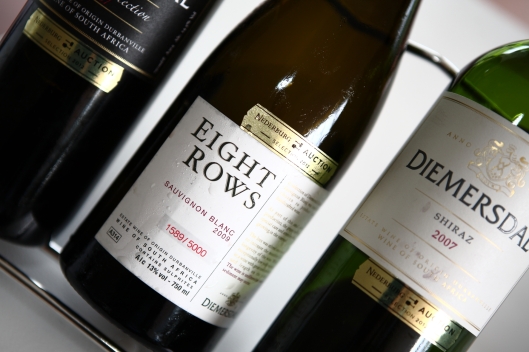Tags
aroma, Blanc Fumé, bouquet, Muscat Silvaner, nose, palate, Sauvignon Blanc, Surin, tasting, wine
| Maybe if called Surin, Blanc Fumé or even Muscat Silvaner, it would not evoke such an emotional response. |
| But alas, Sauvignon Blanc by any other name is still Sauvignon Blanc and when the word is uttered there are either those who love it and will defend it with a passion or those who hate it!
If it was possible to personify this grape as a vocalist, Sauvignon Blanc would most certainly be Chris Chameleon.
Bold, versatile and thunderous in style, Chris hits even the highest notes with an electric, daring edge.
You can expect nothing less from Sauvignon Blanc.
Sauvignon Blanc is a snappy, zesty grape, full of aromatic personality and apart from the Muscat family; Sauvignon Blanc is the only grape variety that actually tastes like a grape in the finished wine.
From humble beginnings in France, where it was cultivated from the early 18th century and mostly blended with Semillon and Muscadelle, Sauvignon Blanc excelled to become a variety that is today being grown around the world, where it has an unique personality and taste in every region.
Initially only small quantities were planted in South Africa, as from 1920. By 1979 the demand for Sauvignon Blanc exploded and new plantings increased exponentially. By November 2011, 28 771 302 Sauvignon Blanc vines were planted on more than 9 644 hectares.
Although Chardonnay remains the most popular white wine, there is no stopping Sauvignon Blanc’s growing popularity worldwide and this grape represents the most likely challenger to the throne.
For many, Sauvignon Blanc also polarised the term ‘cult wine’, having nothing to do with exclusivity or intellect; to the contrary, its magnetism was based on being the consummate social lubricant acceptable and approachable in price and style to all. Surely this is a good thing, unless you’re a complete and utter wine snob.
Marc Hanes (The Hanes Wine Review, October 2005,) also mention a curious and little known fact about Sauvignon Blanc, “Sauvignon Blanc is a “parent” of Cabernet Sauvignon. The latter has been shown to be the result of a spontaneous field crossing between Sauvignon Blanc and Cabernet Franc (a grape which is used to make red wines) in the 18th century in some unknown vineyard in France’s Bordeaux region where Cabernet Franc and Sauvignon Blanc were inter-planted. So, a grape which was used to make white wines is half responsible for the existence of perhaps the world’s most famous grape used to make a red wine. The world is a mysterious and beautiful place.”
Because of its high acidity and crisp, clean taste, Sauvignon Blanc is a great wine to serve with food.
Mostly being in a light- to medium-bodied style, Sauvignon Blanc happily belongs at the beginning of a meal. Its high acidity and crisp style is a match made in heaven for many first courses such as soups, salads, and appetizers.
Sauvignon Blanc also works well with foods that are difficult to pair wine with, like green vegetables and spicy dishes. The herbaceous nature of Sauvignon Blanc pairs perfectly with fresh herbs and its natural acidity enables it to stand up to foods with higher acidity, like goat cheese, tomatoes, and yogurt. Any other wine with less acidity would simply taste flabby with these foods.
Sauvignon Blanc is a seafood wine par excellence! It is best served with shellfish and lighter fish such as sole or cod and also good with acidic Indian dishes and Thai dishes with creamy coconut sauces or even milder aromatic curries.
Tasting Sauvignon Blanc
Look at the Colour
Hold your glass up to the light. Sauvignon blanc is definitely the most well known wine that has hints of green. Sauvignon Blanc colour can vary substantially from brilliantly clear to green-yellow or even golden amber.
Nose the wine
Swirl the wine in your glass; it will release a range of aromas. Take a fast sniff for a first impression. Smell more deeply and slowly. What do you pick up?
Sauvignon Blanc is very distinctive and one of the easier cultivars to identify by its pronounced and aggressive aroma and bouquet profile.
Varietal (from the grape) Aromas include:
Fermentation and wine processing Bouquet include:
Evaluate the taste Take a sip and let it rest in your mouth before swallowing. Consider the taste. Does the taste go away quickly or linger? Is it tart or flabby?
With naturally high acidity, Sauvignon Blanc is always tangy, tart, racy, or zesty.
Consider the palate
Take another sip of wine. Before swallowing, take in a little air. This will activate your senses further. Notice how the wine feels in your mouth. How does the touch affect your tongue and throat as you swallow?
On the future of Sauvignon Blanc, Mike Radcliffe had the following to say; “While Sauvignon Blanc has proved immensely popular with consumers, there has always been a feeling that it is a non-serious variety. You just don’t find many Sauvignons priced £15 and over, whereas for most other varieties, this sort of price ceiling doesn’t exist. For this reason, it’s exciting to see the work being done by Duncan Savage at Cape Point Vineyards. From this cool, maritime spot Duncan has for some years been making one of South Africa’s top Sauvignons. With some oak and a bit of Semillon in the blend, the Cape Point Isliedh is one of the world’s best expressions of Sauvignon, complex and precise and capable of ageing. This is the sort of wine that could see Sauvignon taken much more seriously by the fine wine community.”.
|

